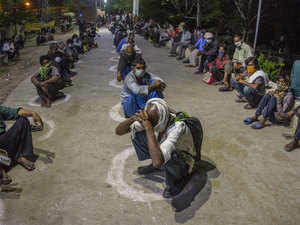
Social distancing was impossible in densely populated urban slums, crowded bazaars and huts where several people slept.

COVID-19 CASES
WorldIndiaConfirmed15,712Deaths507Confirmed2,317,759Deaths159,510Forget caution, India should rapidly ease the Covid shutdown to revive the economy. Otherwise it may suffer the worst of both worlds — economic collapse without checking the virus. At a Princeton University webinar last week, economics Nobel laureate Angus Deaton did not mention India by name, but he highlighted the danger of poor countries getting the worst of both worlds.
Deaton said countries with strong administrations and health systems could enforce social spacing, comprehensive testing, isolation and treatment. This could check the epidemic. But in poor countries with weak administrative and medical capacity, shutdowns would not check the disease. Social distancing was impossible in densely populated urban slums, crowded bazaars and huts where several people slept. Virus testing capacity was weak, so detection, isolation and treatment were highly incomplete, and the disease would spread despite shutdowns.
India is better than African countries, but its administrative capacity is below par. Despite efforts, the rate of testing is less than 20,000 per day, so we have no idea how many people are actually infected. India has 0.7 hospital beds per 1,000 people, one of the lowest ratios in Asia. It has one doctor per 1,404 patients, well below the WHO norm of one per 1,000. It has 1.7 nurses per 1,000 against the WHO norm of 3 per 1,000.
Prime Minister Modi says he has dedicated 602 hospitals, one lakh isolation beds and 12,000 ICU beds to meet the Covid challenge. Many corporations, NGOs, state governments and volunteers are helping out. But if just 1% of India’s population gets infected that means 13 million people. India’s facilities look pathetically inadequate for that.
Enforcing social distancing seems impossible. Massive crowds of migrant workers demand assistance. Community kitchens feed the needy but entail crowding. Bus and train services have been stopped to curb crowding, but millions of migrant workers are marching home in groups, ignoring social distancing. In crowded bazaars and slums, people cannot stay six feet apart for long.
Agricultural mandis are being re-activated for the rabi harvest, but social distancing in mandis is difficult. Farmers growing perishables have lost their entire crop because of curbs on transport.
The IMF predicts India’s GDP growth will drop to 1.9%, as bad as in 1991 when India went bust. If social distancing does not work and the economy fails to revive in the second half of 2020, the IMF says growth will be deeply negative, the worst performance in independent India. This economic disaster will create massive misery that will exacerbate illness and deaths. So, a prolonged shutdown may kill and make more people miserable than it saves.
Being hard-headed does not mean being hard-hearted. Some favour a very gradual easing of the shutdown to check the disease. I suspect that would cause more misery than a rapid revival of the economy. The world has experienced many pandemics (SARS, MERS, the 2018 flu epidemic) that died out without requiring economic shutdowns. The flu of 2017-18 caused 80,000 deaths in the US but no shutdown was ordered. In the case of Covid, the Imperial College, London, projected an explosive virus spread that would kill millions unless tackled on a war footing.
This caused panic and shutdowns the world over. Governments didn’t want to be accused of killing people. An exception was socialist Sweden, which encouraged social distancing but avoided any shutdown. Compared with European countries with shutdowns, Sweden’s infection and death rates are middling. It alone has saved its economy while avoiding a medical disaster, and medically outperformed many shutdown countries.
Countries have decreed shutdowns ranging from mild to very stringent (like India’s). These are causing the greatest economic collapse since the Great Depression. But many experts contest the accuracy or even validity of the Imperial College model. A shutdown “flattens the curve” of infections. But that does not guarantee fewer deaths — they may merely be spread over 18 months rather than four. Deaton says deaths attributed to pandemics are exaggerated by “harvesting”: many who die are infirm people who would have died anyway in the next two years. He says this is why mortality rates always plunge the year after a pandemic.
Data is too limited and suspect to prove or disprove the Imperial College model. Maybe the disease is less lethal and fast-spreading than the model predicts. Maybe it is less effective in tropical countries. Nobody really knows its medical outcomes. But we do know its economic outcome will be dreadful.
Risks exist whether we lift the shutdown gradually or fast. Rapid easing will check the economic disaster but may worsen deaths (though this is uncertain). I prefer this to gradual easing that may give India the worst of both worlds.
Views expressed are personal
Source: indiatimes.com

